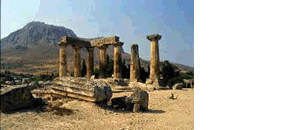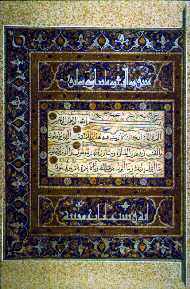 |
|
|
|
|
Class
Prep
|
|
|
|
- Introduction
to Islam
-
 We turn from the image of the hero in ancient Sumer/Babylon/Assyria
to the image of the prophet as hero in Islam. Muhammed,
the great messenger of Islam, was born sometime around 560
CE, and received the first of the revelations that would
become the Qur'an in 609/610 CE. The revelations
would continue until his death in 632 CE.
We turn from the image of the hero in ancient Sumer/Babylon/Assyria
to the image of the prophet as hero in Islam. Muhammed,
the great messenger of Islam, was born sometime around 560
CE, and received the first of the revelations that would
become the Qur'an in 609/610 CE. The revelations
would continue until his death in 632 CE.
-
- The primary readings for today's class are some of the
most significant in the Qur'an. They include
the opening surah or step/chapter, which is a kind
of overture to many key Islamic beliefs about the attributes
of Allah, as well as surahs 96 and 73, which are
Allah's early call to the prophet Muhammad to hear, recite
and share the divine message. The remaining passages
reveal other aspects of the prophet's life.
-
- The Qur'an ("recitation") is understood by faithful
Muslims to be the words of Allah revealed directly to Muhammad. It
helps as you read to remember that it is Allah who is speaking. You
will also notice that your edition of the Qur'an has the Arabic
words alongside the English translation. This is because
the Arabic words themselves are understood to be integral to the
message Allah revealed; in fact, it is considered improper to
translate the Qur'an into any language because some of the original
meaning may be lost, and thus the Arabic must always be provided.
-
- As you read this material, examine the following:
-
-
- What are the attributes of Allah that are praised in surah
1? Do any of these repeat in the other surahs
you are reading?
- Describe the manner in which the prophet Mohammed is "called"
in surahs 96 and 73, as well as you can make it out.
- What cultural values are espoused, and what dominant
values are attacked, in these ayat?
-
-
- Assigned Readings
- Primary: Qur'an, surahs 1 (Al
Fatihah - The Opening); 73:1-10; 74:1-31;
96—97; 17:105-110; 26:192-227;
42:51-53; 81:15-29; 41:44; 17:45-57;
28:57-60; 2:183-200
- Secondary:Begin readnig Esposito, "Mohammed
and the Quran: Messenger and Message" (ERes); online
class prep
-
-
- Further Reading
 Braue, Donald A. "Shi'i Martyr Consciousness and
the Iranian Revolution." Encounter 43
(1982) 377-93.
Braue, Donald A. "Shi'i Martyr Consciousness and
the Iranian Revolution." Encounter 43
(1982) 377-93.
-
 Davidson, Olga M. Poet and Hero in the Persian Book
of Kings. Ithaca, New York: Cornell University
Press, 1994.
Davidson, Olga M. Poet and Hero in the Persian Book
of Kings. Ithaca, New York: Cornell University
Press, 1994.
-
 Esposito, John L. Islam: The Straight Path,
3rd ed. New York: Oxford University Press, 1998.
Esposito, John L. Islam: The Straight Path,
3rd ed. New York: Oxford University Press, 1998.
-
 Hermansen, Marcia K. "The Female Hero in the Islamic
Religious Tradition." In The Annual Review
of Women in World Religions, vol 2 (Albany: State University
of New York Press, 1992) 111-143.
Hermansen, Marcia K. "The Female Hero in the Islamic
Religious Tradition." In The Annual Review
of Women in World Religions, vol 2 (Albany: State University
of New York Press, 1992) 111-143.
-
 Husted, Wayne R. "Karbala Made Immediate: The Martyr as Model in Imami Shi'ism." Muslim World 83 (1993) 263-78.
Husted, Wayne R. "Karbala Made Immediate: The Martyr as Model in Imami Shi'ism." Muslim World 83 (1993) 263-78.
-
 Lyons, M. C. The Arabian Epic: Heroic and Oral Story-Telling,
3 vols., University of Cambridge Oriental Publications 49. New
York: Cambridge University Press, 1995.
Lyons, M. C. The Arabian Epic: Heroic and Oral Story-Telling,
3 vols., University of Cambridge Oriental Publications 49. New
York: Cambridge University Press, 1995.
-
 Renard, John. Islam and the Heroic Image: Themes
in Literature and the Visual Arts, Studies in Comparative
Religion. Columbia: University of South Carolina Press,
1993.
Renard, John. Islam and the Heroic Image: Themes
in Literature and the Visual Arts, Studies in Comparative
Religion. Columbia: University of South Carolina Press,
1993.
-
- Reynolds, Dwight Fletcher. Heroic Poets, Poetic
Heroes: The Ethnography of Performance in an Arabic Oral Epic
Tradition. Ithaca, New York: Cornell University
Press, 1995.
-
 Sells, Michael. Approaching the Qur'an: The Early Revelations. Ashland, Oregon: White Cloud Press, 1999.
Sells, Michael. Approaching the Qur'an: The Early Revelations. Ashland, Oregon: White Cloud Press, 1999.
-
-
- Links
-
-
- Sources
- Photograph: "Page from a Koran, Egypt, 14th Century, Arthur M. Sackler Gallery," slide S86.0066, Arthur M. Sackler Gallery, Washington, D.C.
|
|
|
|
|
